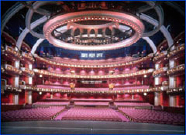March 26, 2003 – Security was tight at the 75th Academy Awards in Los Angeles because of concerns over terrorist threats related to the war in Iraq. The event came off without a hitch, thanks in part to an access control system based on RFID technology from Texas Instruments.
For years, the award ceremony has been the target of gatecrashers who wanted to get inside and mingle with the stars. Three years ago, the Academy of Motion Picture Arts and Sciences hired a company called Security Solutions to do the systems integration for security. The company introduced an RFID system based on Motorola’s BiStatix product, which has been discontinued.
For the past two years, Security Solutions has been using TI’s technology to verify the identity of attendees at entrances to the buildings and at interior checkpoints and restricted-access areas throughout the Kodak Theater, where the awards are held.
Each attendee registers in advance. A photo is taken and stored in a database. The photo and information about each person is linked to a serial number stored on the TI 13.56 MHz smart label. Kiosks containing a computer monitor, RFID reader from Secura Key of Chatsworth, Calif., and computer server were placed at strategic locations.
When guests came within reading distance of kiosk antenna, the computer system would call up their image and information on the monitor. The security guard could then visually confirm that the person wearing the badge was the person who was supposed to be wearing it. In areas where the PCs could not be connected to a local-area network, Security Solutions used wireless technology to retrieve data.
The smart labels embedded in the badges are based the ISO 15693 vicinity card standard. They contain a unique, factory-programmed ID, which cannot be duplicated, ensuring that no two cards or people are misidentified. “These tags are virtually impossible to counterfeit,” says Tim DeWeese, president of Security Solutions. “By putting them inside the badge, we really stepped up the security at the Oscars.”
The microchip in the smart label can store more than 256 bytes of data, or about 30 times more information than traditional 125 KHz proximity cards. That gives the Academy flexibility in designing security solutions, according to DeWeese. One option considered was storing a digital photo on the badge. Then security personnel walking around could go up to a suspicious-looking character anywhere in the facility, read the image off the card and see if the image displayed on his or her PDA matched the person wearing the badge.
The Academy didn’t choose to implement the system this year because of the additional cost involved. There are also two schools of thought about putting more data on the tag. One benefit is the ability to access the information anywhere with a handheld device. The data on the tag might not be up-to-date.
So lets say a photo is stored on a persons RFID tag. The person is removed from the database just before an event. When staff scan the person in the field, there is no way for them to know that the person shouldn’t have been admitted. If the handheld device is reading a serial number and then calling up information from a database through a wireless LAN, then security personnel will have access to the latest information in the database.
On the other hand, storing data on the tag can be more cost effective. “With a one-day show like the Oscars, you might now want to invest in a wireless infrastructure,” says DeWeese. “It just depends on the application.”
In addition to the RFID technology from TI, Security Solutions used C-Cure 800 software from Software House (a division of Tyco) to store the cardholder database. And the badges used embedded visual and color coding technology solutions from CCL Label of Monrovia, Calif.


